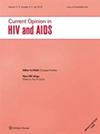Clinical implementation of long-acting antiretroviral treatment in high-income countries: challenges and advantages
IF 4.5
3区 医学
Q2 IMMUNOLOGY
引用次数: 2
Abstract
Purpose of review Long-acting antiretroviral therapy (LA-ART) brings a paradigm shift to HIV care with injectable cabotegravir/rilpivirine (IM-CAB/RPV) in current or imminent use in several countries. This brings the usual opportunities and challenges of a new therapy, plus requirements to adapt services to reliably deliver injections and ensure patients understand advantages and limitations. We summarise key considerations for implementation in high-income countries. Recent findings Monthly IM-CAB/RPV is noninferior to oral ART and monthly IM-CAB/RPV to 1-monthly in carefully selected virally suppressed people. The numerically higher virological failure rate on two-monthly IM-CAB/RPV warrants close attention and careful monitoring. Implementation projects report positive experiences for patients and staff, but also barriers. Data is needed in younger people, pregnancy/breastfeeding, and in those with detectable viraemia secondary to suboptimal adherence. Summary We highlight a paucity of real-world data and key unanswered questions. Existing data on injection techniques may have implications for training; monitoring of outcomes is crucial to ensure clinical trial results are replicated in real-life. Better understanding of treatment failure, and individualised therapy, is crucial, and it is important to repeat patient preference surveys as new data emerges to ensure decisions are based on the most recent evidence of benefit vs risk.高收入国家长效抗逆转录病毒治疗的临床实施:挑战与优势
长效抗逆转录病毒疗法(LA-ART)在一些国家目前或即将使用的可注射卡波特韦/利比韦林(IM-CAB/RPV)带来了艾滋病毒治疗的范式转变。这给新疗法带来了通常的机遇和挑战,此外还需要调整服务,以可靠地提供注射,并确保患者了解优势和局限性。我们总结了在高收入国家实施的关键考虑因素。在精心挑选的病毒抑制人群中,每月IM-CAB/RPV不低于口服ART,每月IM-CAB/RPV低于1个月。两个月的IM-CAB/RPV的病毒学失败率较高,值得密切关注和仔细监测。实施项目报告了患者和工作人员的积极经验,但也存在障碍。需要在年轻人、怀孕/母乳喂养者以及继发于次优依从性的可检测到的病毒血症患者中提供数据。我们强调缺乏真实世界的数据和关键的未解问题。关于注射技术的现有数据可能对培训有影响;监测结果对于确保临床试验结果在现实生活中得到复制至关重要。更好地了解治疗失败和个性化治疗是至关重要的,随着新数据的出现,重复患者偏好调查以确保决策基于最新的获益与风险证据是很重要的。
本文章由计算机程序翻译,如有差异,请以英文原文为准。
求助全文
约1分钟内获得全文
求助全文
来源期刊

Current Opinion in HIV and AIDS
IMMUNOLOGY-INFECTIOUS DISEASES
CiteScore
7.40
自引率
7.30%
发文量
115
审稿时长
6-12 weeks
期刊介绍:
Published bimonthly and offering a unique and wide ranging perspective on the key developments in the field, each issue of Current Opinion in HIV and AIDS features hand-picked review articles from our team of expert editors. With six disciplines published across the year – including HIV and ageing, a HIV vaccine, and epidemiology – every issue also contains annotated reference detailing the merits of the most important papers.
 求助内容:
求助内容: 应助结果提醒方式:
应助结果提醒方式:


